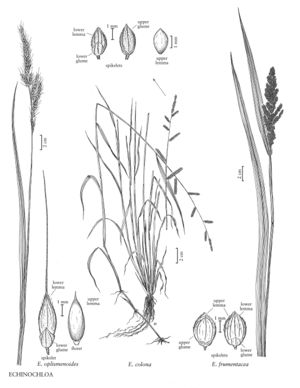Difference between revisions of "Echinochloa oplismenoides"
FNA>Volume Importer |
FNA>Volume Importer |
||
| Line 17: | Line 17: | ||
-->{{Treatment/Body | -->{{Treatment/Body | ||
|distribution=Ariz. | |distribution=Ariz. | ||
| − | |discussion=<p>Echinochloa oplismenoides was first found in the United States, in southern Arizona, in 1993 (Fishbein 1995). It was previously known only from Mexico, with a range that extends from northwestern Mexico to Guatemala. The southern Arizonan plants were found near a cattle tank in wet grasslands. Fishbein stated that it was impossible to tell whether they represented a previously overlooked native species or an introduction.</p> | + | |discussion=<p><i>Echinochloa oplismenoides</i> was first found in the United States, in southern Arizona, in 1993 (Fishbein 1995). It was previously known only from Mexico, with a range that extends from northwestern Mexico to Guatemala. The southern Arizonan plants were found near a cattle tank in wet grasslands. Fishbein stated that it was impossible to tell whether they represented a previously overlooked native species or an introduction.</p> |
|tables= | |tables= | ||
|references= | |references= | ||
| Line 26: | Line 26: | ||
-->{{#Taxon: | -->{{#Taxon: | ||
name=Echinochloa oplismenoides | name=Echinochloa oplismenoides | ||
| − | |||
|authority=(E. Fourn.) Hitchc. | |authority=(E. Fourn.) Hitchc. | ||
|rank=species | |rank=species | ||
| Line 33: | Line 32: | ||
|basionyms= | |basionyms= | ||
|family=Poaceae | |family=Poaceae | ||
| − | |illustrator=Linda A. Vorobik | + | |illustrator=Linda A. Vorobik;Hana Pazdírková |
| + | |illustration copyright=Utah State University | ||
|distribution=Ariz. | |distribution=Ariz. | ||
|reference=None | |reference=None | ||
| Line 39: | Line 39: | ||
|publication year= | |publication year= | ||
|special status= | |special status= | ||
| − | |source xml=https:// | + | |source xml=https://jpend@bitbucket.org/aafc-mbb/fna-data-curation.git/src/f50eec43f223ca0e34566be0b046453a0960e173/coarse_grained_fna_xml/V25/V25_1117.xml |
|subfamily=Poaceae subfam. Panicoideae | |subfamily=Poaceae subfam. Panicoideae | ||
|tribe=Poaceae tribe Paniceae | |tribe=Poaceae tribe Paniceae | ||
Revision as of 21:31, 16 December 2019
Plants annual. Culms to 100 cm, erect, succulent, glabrous, branching from the lower nodes. Sheaths glabrous or hispid with papillose-based hairs; ligules absent or the ligule region pubescent; blades 10-35 cm long, 5-10 mm wide. Panicles 15-30 cm, narrow; primary branches appressed to ascending, with papillose-based hairs at the base of the spikelets. Spikelets 4-5 mm, disarticulating at maturity. Glumes with hairs over the veins, glabrous, scabrous, or hispid between the veins; upper glumes about equal to the spikelets, muticous or awned, awns to 1 mm; lower florets sterile; lower lemmas unawned or awned, awns 8-16(50) mm; lower paleas absent or hyaline and subequal to the lemmas; upper lemmas 4-4.5 mm long, 1.7-1.9 mm wide, elliptic; anthers 0.5-0.7 mm, purple. Caryopses 2.7-2.9 mm long, 1.7-1.8 mm wide, elliptic in outline, mucronate; embryos about 75% as long as the caryopses; hila obovate. 2n = unknown.
Distribution
Ariz.
Discussion
Echinochloa oplismenoides was first found in the United States, in southern Arizona, in 1993 (Fishbein 1995). It was previously known only from Mexico, with a range that extends from northwestern Mexico to Guatemala. The southern Arizonan plants were found near a cattle tank in wet grasslands. Fishbein stated that it was impossible to tell whether they represented a previously overlooked native species or an introduction.
Selected References
None.
